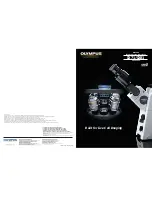
6
Do not remove eyepieces or objective lenses to clean. Clean only the outer lens surface. Breath on lens to dampen
surface, then wipe with lens paper or tissue or use a cotton swab moistened with distilled water. Wipe lenses with a
circular motion, applying as little pressure as possible. Avoid wiping dry lens surface as lenses are scratched easily. If
excessive dirt or grease gets on lens surfaces, a small amount of Windex can be used on a cotton swab or lens
tissue. To clean objective lenses, do not remove objectives from microscope. Clean front lens element only, following
same procedure.
NOTE: Fingerprints or other matter on the front lens element of the objective lens is the single most common reason
that you will have difficulty in focusing the microscope. Before having costly servicing done, or before returning to
National for “warranty repair”, make certain to examine the front lens element with a magnifying glass or eye loupe for
the presence of such contaminants. If a microscope is returned to National for warranty repair, and it is determined
that such contaminants are the problem, this is not covered under warranty and National will submit a cost estimate for
cleaning.
2. MECHANICAL MAINTENANCE
a. The rack stop screw has been pre-adjusted at the factory and should not require re-adjustment. However, if you
do attempt re-adjustment, note the following procedure.
Using a 2mm “L” type hex key wrench, loosen rack stop hex socket set screw by rotating in a counterclockwise
direction. With fine focus adjustment at mid-range, focus on a standard slide until sharp image is obtained.
Rotate rack stop screw in clockwise direction until tight
b. Coarse focus tension adjustment prevents the stage from drifting down from its own weight and causing the image
to move out of focus. This has been adjusted at the factory, but over the course of time it may loosen and cause
the stage of the microscope to slip downward on the focusing block.
The tension adjustment collar is located between arm and coarse focus knob on left side of microscope. With
0.90mm “L” type key wrench, loosen the set screw located in the hole on tension adjustment collar. Turn collar
clockwise to tighten tension, counter-clockwise to loosen tension. Use of a wide rubber band will provide a better
grip on the tension adjustment collar. After adjusting, tighten the set screw to lock collar in place.
NOTE: It is recommended that you leave the tension as loose as possible for ease of focusing, yet not so loose
that it permits the stage of microscope to drift downward from its own weight and cause the microscope to “drift”
out of focus.
c. Metal parts: Use a clean, damp cloth to remove dust or dirt from metal parts, followed by a dry cloth.
3. ELECTRICAL MAINTENANCE
211/212 Maintenance:
a. Replacing LED element:
An LED “bulb” will last up to 50,000 hours so you don’t have to do this exercise very often.
To open the illuminators field lens housing, use 0.9mm “L” type hex key wrench supplied with your microscope.
Loosen hex screws on lens housing. Remove lens housing to expose LED “bulb”. Remove bulb by grasping the
plastic base of bulb and gently pulling straight up. Insert new LED “bulb”, replace lens housing and tighten hex
screw to secure lens housing in place.
b. Replacement of fuse:
The fuse is located at the rear right side of microscope base. To remove fuse from holder, insert a 6mm
screwdriver blade into slot located in rear of fuse holder cap. Slightly depress and rotate screwdriver ¼ turn in
direction of arrow, release pressure on screwdriver to release fuse. Pull cap and fuse out of fuse holder. Insert
proper fuse into fuse cap. Insert fuse cap into fuse holder. Using screwdriver, rotate fuse cap assembly in
opposite direction of arrow until slot engages, depress fuse cap and rotate ¼ turn to lock into fuse holder.
211-RLED/212-RLED Maintenance:
The extent of electrical maintenance, by other than a qualified technician,
should be LED replacement, battery recharging and battery replacement. Before maintenance, be sure that recharger
is not connected to microscope.
a. Recharging batteries:
Plug output cord from battery charger into DC recharging socket located on back of microscope base. Your
automatic switching recharger operates on 100 to 240 volts AC 50/60 Hz, plug recharger into your AC wall outlet.
The red LED indicator lamp located on recharger will be illuminated when batteries are receiving maximum
charge. After batteries are charged, the red LED indicator lamp will turn to green and charger automatically
switches to “trickle charge”. The charger can be left plugged in, but for safety reasons it is a good idea to
























